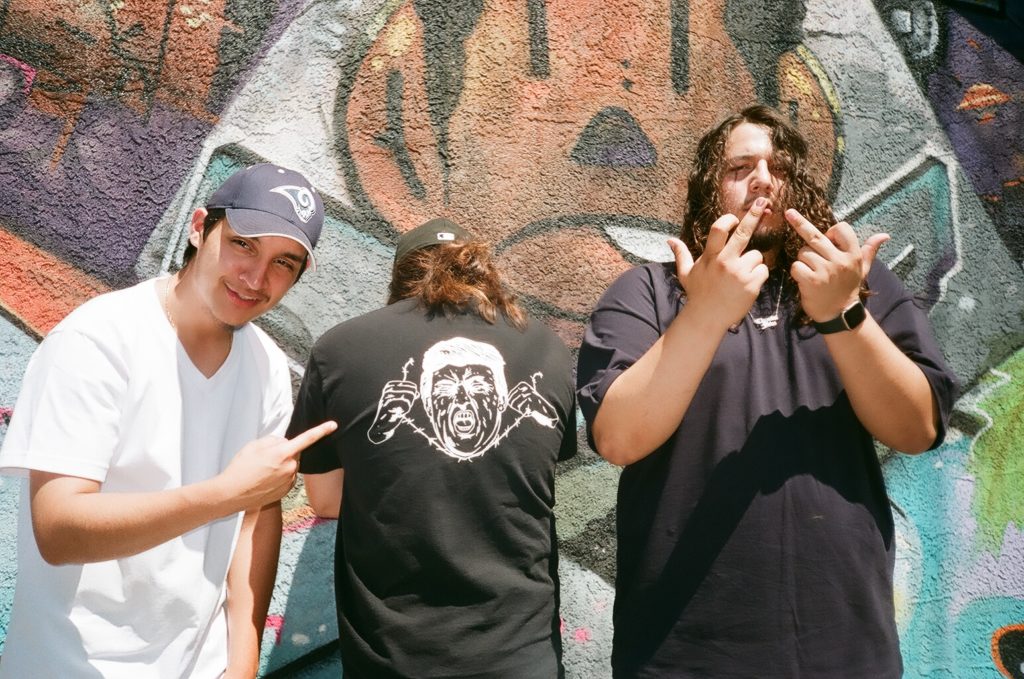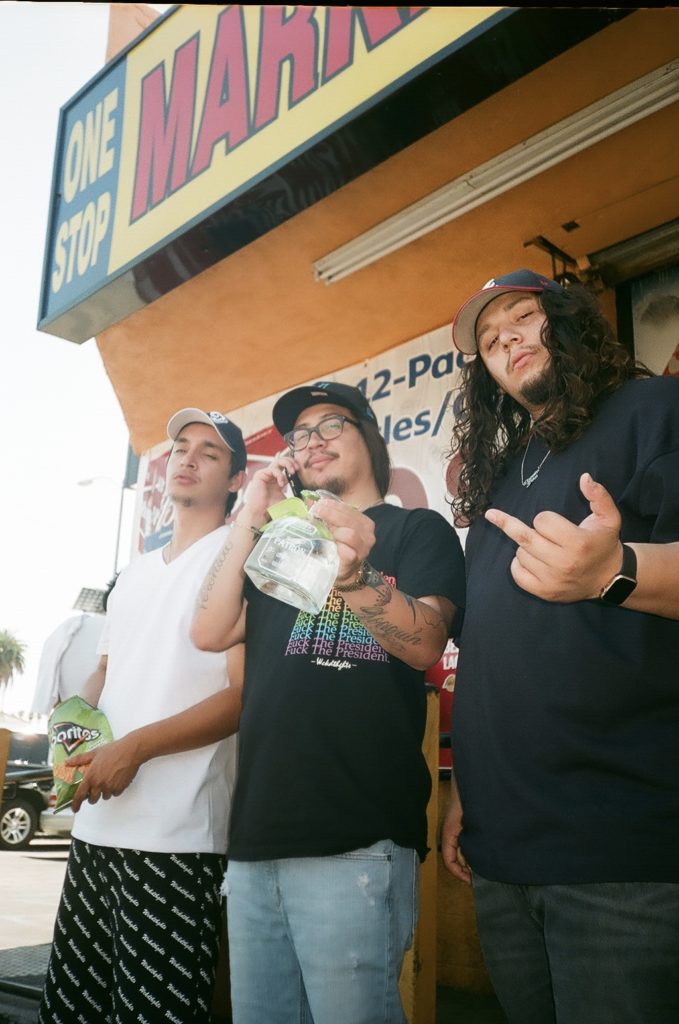For a neighborhood that rarely attracts outsiders, the name “Crenshaw” commands worldwide notoriety.
Even before Nipsey Hussle turned Crenshaw and Slauson into one of the most fabled L.A. intersections since Hollywood and Vine, it was already renowned as a hub of African American culture. This is the place that birthed the legendary G-Funk producer Battlecat and the psychedelic innovator Arthur Lee of Love. It’s where the characters of John Singleton’s Boyz n The Hood lived and died. The ancestral home of Darryl Strawberry and former Mayor Tom Bradley. And now, it has produced three Central American rappers, who might be the next to break out of the L.A. rap world.
From the unorthodox spelling of their name to their ability to bridge cultural divides, the Chosin Few refuse to conform to expectations. Just take a look at the trio’s de facto frontman, Eric Alvarado. Better known as Evxga, the 22-year old is far from your archetypal L.A. rapper. Half-Salvadoran and half-Honduran, he’s heavy-set, with long curly hair. Today, he sports a plain Pro Club t-shirt, an Atlanta Braves hat, and a silver “Chosin Few’’ chain. He holds a case of Pacifico and offers a cold bottle to everyone gathered on this porch in the Rollin 40s neighborhood of South Central.
The block, as they refer to it, is roughly two miles from Nipsey Hussle Square. Like many in the area, this house features a long driveway, a nice-sized front yard and access to an alley. As Project Crenshaw bulldozes on, this neighborhood will drastically change in the coming years as has neighboring Inglewood, with the building of So-Fi Stadium and the renovation of The Forum. For now, gathering in the front yard, drinking beer and taking dab hits on a hot summer day is done without protest from neighbors or authorities.
“This is my road dawg,” Alvarado says, enthusiastically showing off his new tattoo. It reveals a nearly finished portrait of Dave-o, his best friend in high school who overdosed on Xanax a week before their graduation in 2016. “We went to juvenile hall together,” he continues. “He was the only homie I had in school. When he died, he was the only one that was supporting my music. That’s when I started rapping.”
The dominant sound of contemporary L.A. rap reflects the sonic legacy of G-Funk, the minimalist piano menace of the ratchet era, 808 drums, and lyrics that stick close to palm trees, pistols, and pretty women; Chosin Few are markedly different.
They sound like students who learned to rap in a gothic classroom taught by Bones and Bone Thugs. It’s evident in the music video for their self-titled song, which cuts between eerie scenes of Evxga in a black hood with a blood-red backdrop and he and his crew partying in front of their neighborhood liquor store.
It’s this singularity that led the prominent management company R Baron to sign them. Run by T.K. Kimbro and Jeremiah “Picaso” Aubert, the firm and record label has nurtured the careers of some of the scene’s biggest artists, including Shoreline Mafia, AzChike, 1TakeJay, and production juggernaut Hit Mob.
“Once I saw the branding in their video as well as the energy it drew me in,” Aubert says. “Once I listened to them actually rap, I loved how they all had completely different styles. I was sold when I found out that they were from around the way and had the respect from everyone in their neighborhood. These are three of the most humble and focused artists that I’ve worked with.”
Back on the porch, Alvarado talks about his upbringing. Lots of skateboarding and graffiti writing. Long bike rides listening to Chief Keef and early Spaceghostpurrp.
“I grew up a block away from here, but my Mom took me to Fairfax High School every morning,” he says, taking a hit of a dab. To this day, she cleans a house for a wealthy family in Hancock Park and used the family’s address to send her kids to better middle and high schools. “She wanted to give me a better opportunity.”

Despite his mom’s valiant efforts, her son still wound up in juvenile hall, as well as Phoenix House, a center for teens that provides help for mental health and drug abuse addiction.
It was around this same time when Alvarado began rapping, forming a group with his brother Marlon and another friend. They called themselves Trench Mob.
At the time, the notion of being an L.A. rap star of Latin American descent seemed like a nearly impossible dream. The Mexican-American rapper OhGeesy of Shoreline Mafia only recently shattered the glass ceiling for L.A. Latinx rappers, who had previously been boxed into Chicano rap stereotypes. Just as Cypress Hill, Kid Frost, and Lighter Shade of Brown did for the previous generations, Ohgeesy’s emergence heralded new possibilities.
Of course, anyone familiar with L.A. rap has known that the city’s 1.5 million-plus Latinx residents are among its most die-hard fans. Yet they aren’t monolithic. The same Spanglish-fluent teenager might be into Cuco and Morrissey, Shoreline and Slipknot — or any one of the constellations of backyard Latinx punk bands that you might catch in South Central or East L.A. It’s this type of eclecticism that defines Marlon Gutierrez, who raps as Mars The Martian. At 28, he’s the elder Alvarado sibling, though he and his brother Eric could practically be fraternal twins.
“My uncle had a band. So I really grew up listening to rock,” Gutierrez explains. He wears a long slick ponytail, a black New Era fitted Marlins hat, and a shirt that reads “Fuck The President.” “We used to go to shows at the Whisky a Go Go. I was into Slipknot, System of A Down, Papa Roach, and Kurt Cobain.”

Born in Santa Rosa, El Salvador, his family fled the Salvadoran Civil War in the early 90s. After a stop in Honduras, he arrived in the U.S. at 9 years old in the year 2000. For someone who grew up in South Central, he discovered hip-hop relatively late. It was only in the 8th grade when he began to get into rappers like Lil Wayne and Tha Dogg Pound.
It was anything but easy growing up in a Crip neighborhood as a long-haired Salvadoran kid whose only friends were black. He had to constantly prove himself to justify his place on the block. “I almost ended up getting put on [to the hood], but I had a big homie named J Stone, rest in peace,” Gutierrez says. “He pulled me to the side and told me, “You always gonna be family, but you don’t gotta do that.’”
Then there is the third member of the group, Miguel Moran. The 24-year-old who calls himself Statue is fittingly the most stone-faced and tight-lipped member of the crew. He claims to be the one who never took rap seriously. However, his humble demeanor doesn’t translate to his verses, as he may be the most aggressive rapper in the crew. On “Rocky Road,” his lone solo track on the Chosin Few debut, he thunders, “Don’t come in my lane, now they riding the wave, they talking mightily brave, when we come around they just hide and behave, it’s the Chosin Few til’ I lie in the grave.”
“I always used to battle rap in the neighborhood for fun,” he says, wearing a navy blue Rams hat, V-neck white tee, and black shorts. “I never took it seriously until Eric got a mic and we started recording in his mom’s Lexus. We record all of our songs in the car, it sounds better in there than when we record in the studio.”
Of the trio, he came the closest to getting out of the hood.
“I got accepted into a private art [college], but it was hella expensive so I stopped going,” he said. As a way of making ends meet as a young father, he put down the paintbrush and picked up a straight razor. By day, he works as a barber following in his mother’s footsteps. She came to this country and began working in a beauty supply warehouse. Taking advantage of her day job, she began buying her own beauty supplies and taught herself how to cut hair. Without ever attending beauty school, she now makes her living cutting hair at home.
There’s a natural reason to be skeptical about any rap group’s odds of winding up on the main stage at Rolling Loud — especially one who will still have to overcome the steep obstacle of being a Latin rap group in an industry that hasn’t produced a platinum Latin rap group since Cypress Hill. As the three continue to juggle day jobs and limited resources, they’ve only released one project to date, their 2017 self-titled debut. While their output isn’t prolific, their determination remains impressive. The trio has been quietly working, waiting for the perfect time to present their music in the best light. They currently have a new project produced entirely by producer, DJ and scene linchpin, Cypress Moreno — which will be followed by their Triune EP.
During their two-plus decades on earth, the members of Chosin Few have survived the death of close friends and dire poverty to get to a place where they can open up for an internationally acclaimed group like Shoreline Mafia. They make eerie dungeon music that sounds like something Dracula would have on his playlist, that’s also capable of resonating with fans of opiated nervous rap music too. And of course, being from the same neighborhood that spawned Nip, they are very aware that the marathon must continue.
“As soon as the ambulance took Nipsey, shit went crazy,” Alvarado says, waving his arms into the air. “You can still feel the sadness around here.”
Then he pauses and takes a breath, commenting on the neighborhood and circumstances that produced them — aware that nothing is promised today or tomorrow.
“We’re very spiritual,” he continues. “That’s why our music sounds the way it does. Even our name comes from a spiritual place. Those who die are the chosen ones, we who survive are the chosen few.”
This article appears in Vol. 2, Issue 2 of The LAnd. Click here to order your copy.